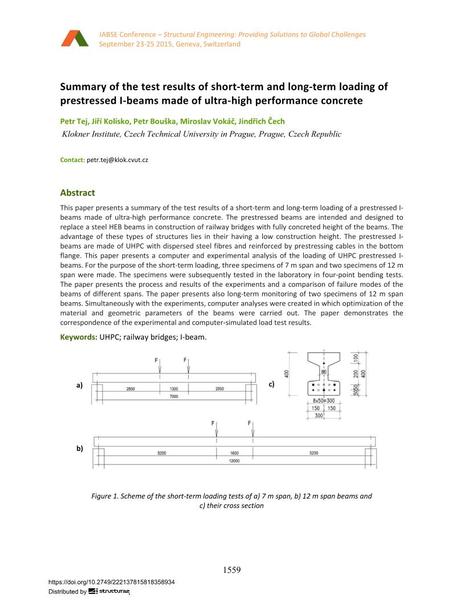Summary of the test results of short-term and long-term loading of prestressed I-beams made of ultra-high performance concrete

|
|
|||||||||||
Bibliografische Angaben
| Autor(en): |
Petr Tej
(Klokner Institute, Czech Technical University in Prague, Prague, Czech Republic)
Jiří Kolísko (Klokner Institute, Czech Technical University in Prague, Prague, Czech Republic) Petr Bouska (Klokner Institute, Czech Technical University in Prague, Prague, Czech Republic) Miroslav Vokáč (Klokner Institute, Czech Technical University in Prague, Prague, Czech Republic) Jindřich Čech (Klokner Institute, Czech Technical University in Prague, Prague, Czech Republic) |
||||
|---|---|---|---|---|---|
| Medium: | Tagungsbeitrag | ||||
| Sprache(n): | Englisch | ||||
| Tagung: | IABSE Conference: Structural Engineering: Providing Solutions to Global Challenges, Geneva, Switzerland, September 2015 | ||||
| Veröffentlicht in: | IABSE Conference Geneva 2015 | ||||
|
|||||
| Seite(n): | 1559-1565 | ||||
| Anzahl der Seiten (im PDF): | 7 | ||||
| Jahr: | 2015 | ||||
| DOI: | 10.2749/222137815818358934 | ||||
| Abstrakt: |
This paper presents a summary of the test results of a short-term and long-term loading of a prestressed I- beams made of ultra-high performance concrete. The prestressed beams are intended and designed to replace a steel HEB beams in construction of railway bridges with fully concreted height of the beams. The advantage of these types of structures lies in their having a low construction height. The prestressed I- beams are made of UHPC with dispersed steel fibres and reinforced by prestressing cables in the bottom flange. This paper presents a computer and experimental analysis of the loading of UHPC prestressed I- beams. For the purpose of the short-term loading, three specimens of 7 m span and two specimens of 12 m span were made. The specimens were subsequently tested in the laboratory in four-point bending tests. The paper presents the process and results of the experiments and a comparison of failure modes of the beams of different spans. The paper presents also long-term monitoring of two specimens of 12 m span beams. Simultaneously with the experiments, computer analyses were created in which optimization of the material and geometric parameters of the beams were carried out. The paper demonstrates the correspondence of the experimental and computer-simulated load test results. |
||||
| Stichwörter: |
Eisenbahnbrücken UHPC
|
||||


